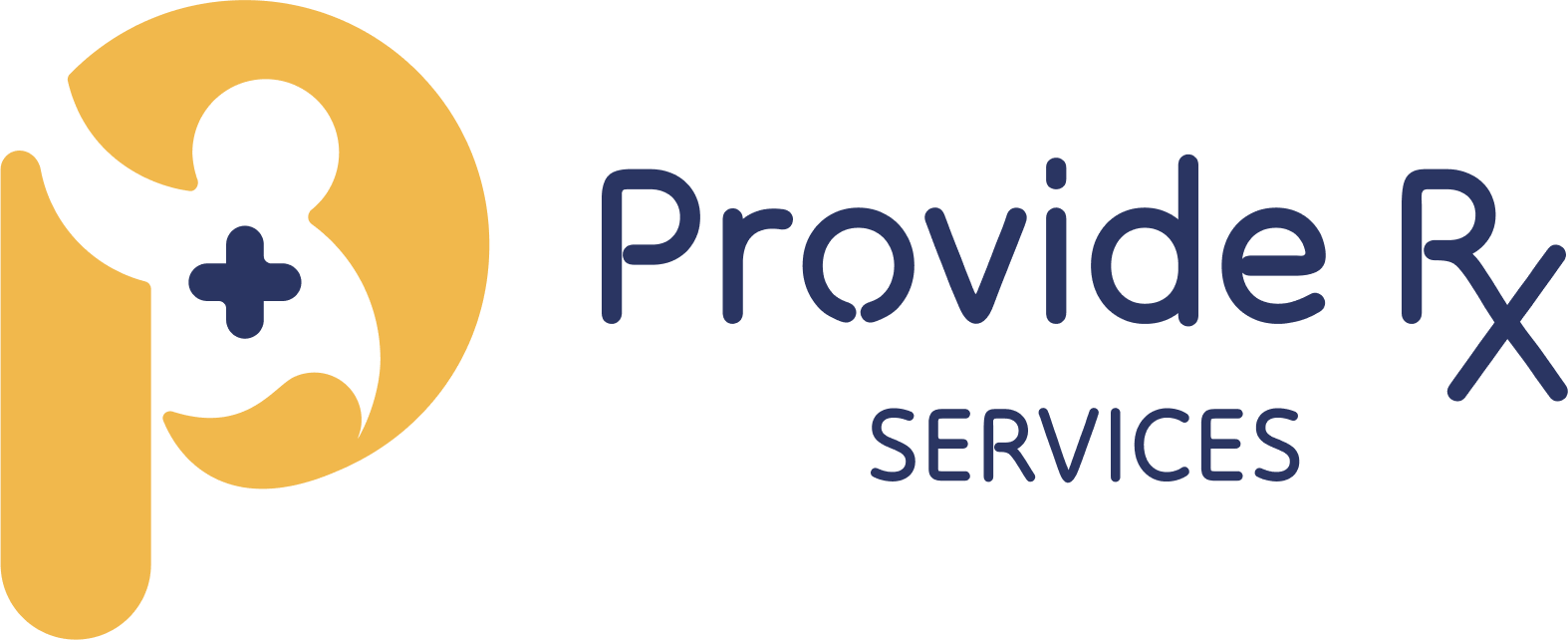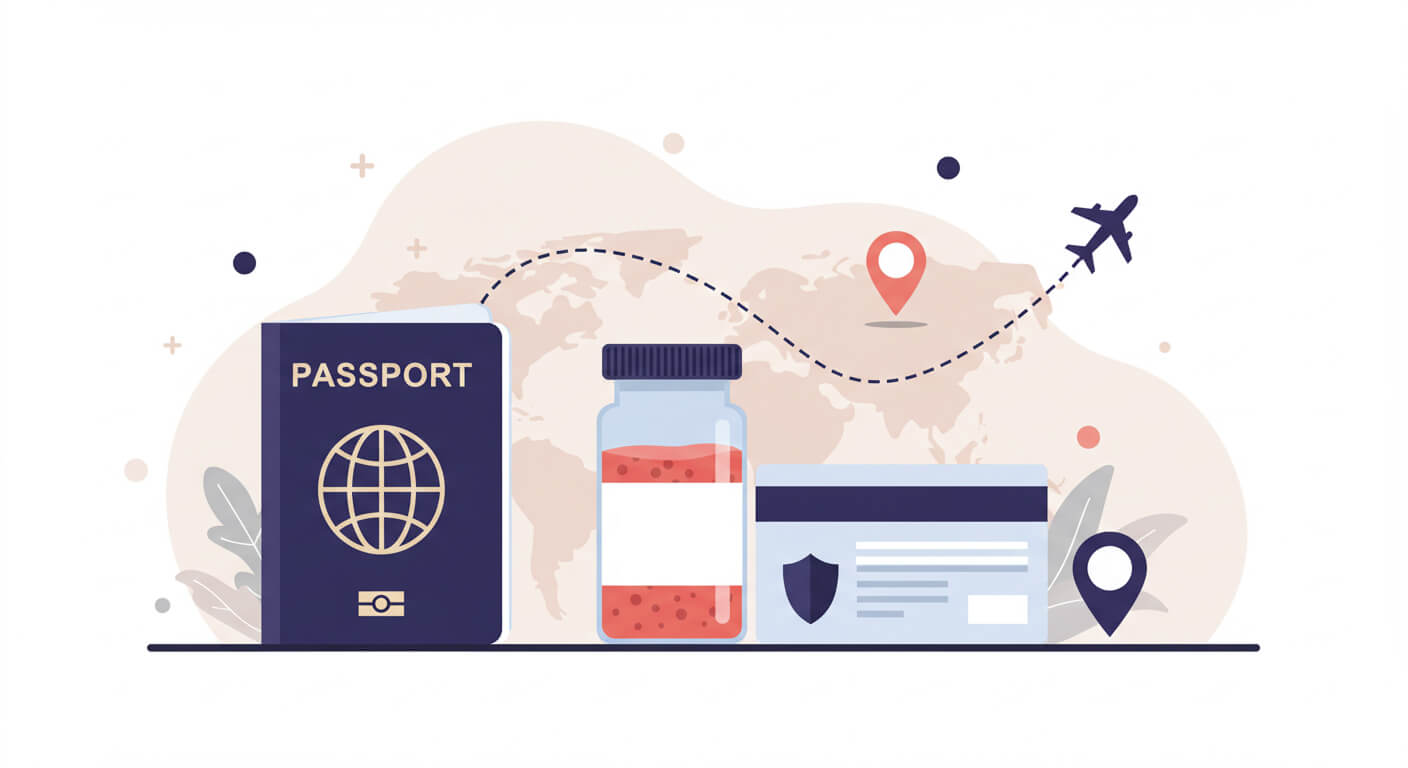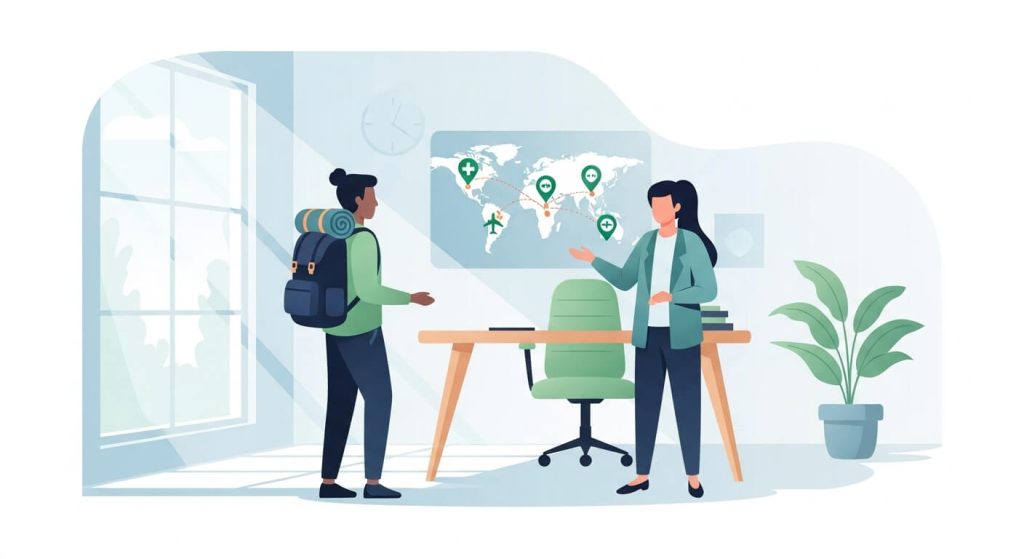Medical tourism and insurance rarely align automatically. Most U.S. plans don’t cover purchases or care abroad outside their network. Confirm exceptions in writing, ask how reimbursement works, carry required documentation, and consider travel medical coverage for emergencies—separate from the cost of buying your prescriptions internationally. When planned well, medical tourism and insurance can coexist: you travel for licensed pharmacy purchases while protecting yourself with clear documentation and contingency coverage.
If you rely on high-cost specialty therapies, the path to savings can include licensed international pharmacies in Mexico—especially Tijuana for same-day access—coordinated by a compliant concierge. To understand how medical tourism and insurance intersect, start with a solid overview of the cross-border process in What Is Medical Tourism for Prescription Medications and How Does It Work? so you see how prescriptions, logistics, and documentation fit together before you talk to your insurer.
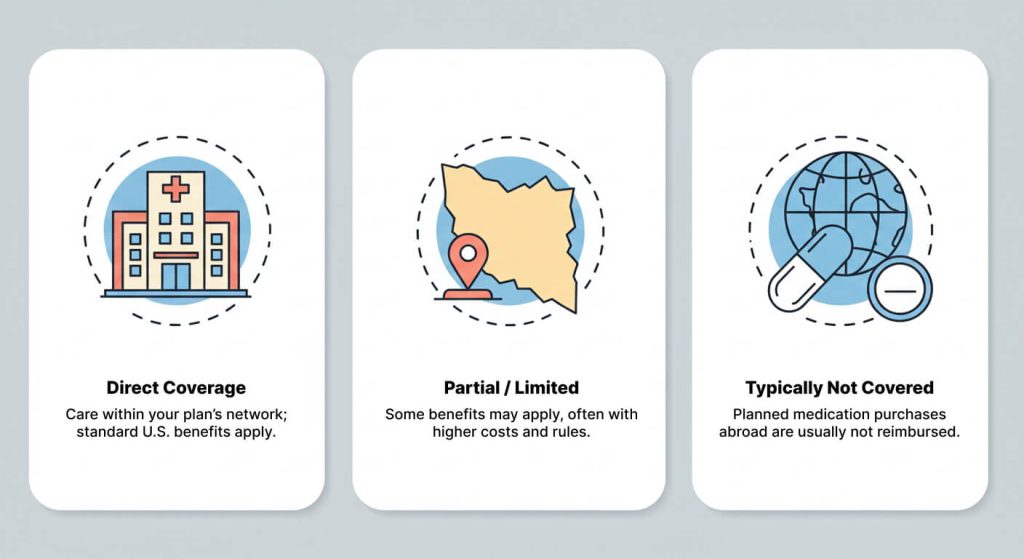
THE ESSENTIALS: HOW MEDICAL TOURISM AND INSURANCE INTERACT
Network & geography limits
Most policies restrict benefits to in-network providers inside the U.S. Even out-of-network benefits often exclude non-U.S. services, and prescription purchases abroad are typically outside benefit design—so don’t expect your insurer to pay a foreign pharmacy directly. The CDC’s medical tourism guidance reinforces planning as if coverage won’t apply overseas unless stated in writing. Treat medical tourism and insurance as parallel tracks: coverage rules at home, purchase logistics abroad.
Emergency vs. planned care
“Emergency abroad” benefits (if any) are designed for unexpected events—not scheduled trips for medication refills. Ask your plan for written definitions of “emergency,” “urgent,” and “medically necessary,” because those terms drive claim decisions. The U.S. State Department’s Medicine & Health page also distinguishes routine purchases from emergencies and stresses proper documentation at the border. Clarifying this boundary keeps medical tourism and insurance aligned and prevents denied claims.
Prior authorization is U.S.-centric
If your medication requires prior authorization, that approval usually applies only to U.S. dispensing. It doesn’t transfer to an international pharmacy unless your plan explicitly states otherwise.
Reimbursement mechanics
If your plan allows any reimbursement, expect a manual claim: original itemized receipts, a copy of your U.S. prescription, and sometimes certified translations. Request the exact claim form and required fields before you travel, including any translation format standards. Ask for the form name in writing; precision is what makes medical tourism and insurance work in practice.
WHAT TO ASK YOUR INSURER
- “Do you cover any services or prescription purchases outside the U.S.?”
Get the answer in writing. If “no,” ask about emergency exceptions and documentation requirements. - “If reimbursement is possible, what documents are mandatory?”
Expect to keep: your U.S. prescription, itemized pharmacy receipt, and proof of travel dates. Some plans want translations. - “Will travel medical insurance change how prescriptions are covered?”
Travel medical policies mainly address emergencies and typically don’t pay for planned medication purchases. They’re still valuable for urgent care. - “Do I need pre-notification or case management?”
Missing a required phone call can void limited benefits. - “How do you define ‘medical necessity’ and ‘emergency’ abroad?”
Claims adjudication will follow those definitions—request them now. - “Are translations required, and into which format?”
Untranslated receipts can stall or sink a claim.
TRAVEL MEDICAL COVERAGE 101 FOR MEDICAL TOURISM AND INSURANCE
A short-term travel medical policy complements your U.S. plan by focusing on emergencies while you’re abroad. It is not a substitute for prescription coverage overseas. Review: deductibles, benefit caps, pre-existing condition rules, evacuation/repatriation, and 24/7 assistance numbers. This layer won’t buy your meds—but it can prevent a small mishap from becoming a financial crisis.
For a destination-specific view of logistics, border timing, and how a vetted concierge reduces uncertainty, see Medical Tourism in Tijuana: Affordable Prescription Access for Americans, then return to this insurance checklist to map coverage questions to your exact travel plan.
COMPLIANCE & DOCUMENTATION FOR MEDICAL TOURISM AND INSURANCE
Good documentation protects you if reimbursement is possible and smooths your return home. Carry a printed and digital U.S. prescription, ensure your ID matches receipts, and keep proof of travel dates. The CDC guidance recommends keeping everything organized from the start. Your document pack is the bridge between medical tourism and insurance, proving who you are, what was purchased, and when.
Prescription proof
Carry a printed and digital copy of your valid U.S. prescription with your full name, medication name, strength, and directions.
Identity consistency
Ensure your ID, prescription, and receipts match exactly.
Itemized receipts
Ask the pharmacy for an itemized receipt with drug name, quantity, and date. When available, keep lot/batch details and storage instructions.
Cold-chain handling
For temperature-sensitive medications, bring an insulated bag and gel packs. Keep purchase receipts for these supplies.
Paper trail hygiene
Save boarding passes, border-crossing records, and lodging confirmations (if applicable). If a claim is possible, those artifacts help validate dates and locations. The CDC guidance recommends this level of preparation as standard.
Privacy
When sharing medical files with a concierge, confirm HIPAA-grade channels and least-access handling. For a broader planning context—destinations, timing, and how to avoid friction at the border—scan Top Medical Tourism Destinations for U.S. Patients in 2025 to see why border hubs streamline documentation and travel windows.
WHY TIJUANA WORKS PRACTICALLY
Border proximity enables same-day travel, predictable itineraries, and access to licensed international pharmacies. A vetted concierge coordinates the schedule, local transfers, and documentation flow while keeping your U.S. clinician in charge of prescribing and the licensed pharmacy in charge of dispensing. The U.S. State Department highlights the importance of carrying medications in original packaging and keeping your prescription handy—habits that make crossings smoother.
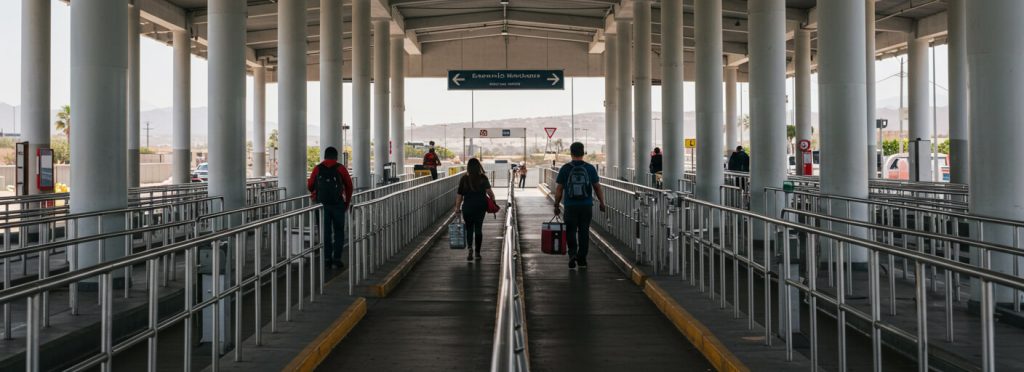
RISK MANAGEMENT WITHOUT DRAMA
Source integrity
Use only licensed pharmacies. Review labels before leaving and keep medications in original packaging.
Chain of custody
Minimize temperature excursions; confirm storage on the label matches your travel plan.
Counterfeit avoidance
Avoid informal vendors or open-air markets. If something seems off, don’t buy.
Medical backup
Carry a brief treatment summary and emergency contacts.
Personal limits
Discuss travel readiness with your clinician—especially mobility, heat, and expected border wait times.
Vigilance around source integrity, temperature control, and original packaging helps you avoid setbacks; it keeps medical tourism and insurance focused on outcomes, not hassles.
THE CONCIERGE ROLE—WHAT IT DOES (AND DOES NOT) DO
A legitimate concierge does not prescribe, sell, or ship medications; it coordinates your itinerary, verifies licensed options, prepares your documentation checklist, and guides storage/transport logistics. That separation keeps the process compliant and patient-first: your clinician prescribes, the licensed pharmacy dispenses, and the concierge organizes—exactly how medical tourism and insurance stay aligned.
STEP-BY-STEP PLAN FOR FIRST-TIMERS
- Confirm prescription details and timing with your U.S. clinician.
- Get written answers from your insurer to the six key questions above.
- Decide on travel medical coverage for emergencies.
- Coordinate border timing and pharmacy visit with a vetted concierge.
- Assemble a document pack: ID, prescription, cooler/gel packs, and claim forms if applicable.
- Verify labels and instructions before leaving the pharmacy.
- Back home, update your clinician; file any insurer paperwork you pre-qualified.
REALISTIC SAVINGS EXPECTATIONS
Patients often report meaningful percentage savings versus typical U.S. costs for certain therapies. Exact figures vary by medication, dosage, and market conditions. Prioritize quality, documentation, and safety over chasing a number; well-executed trips tend to deliver the most dependable value.
LEGAL & ETHICAL BOUNDARIES YOU SHOULD KNOW
Personal-use import
U.S. rules allow limited quantities for personal use. Carry your prescription and keep original packaging.
No resale
Your medication is for you only.
No cross-border shipping
This guide focuses on in-person purchases. Shipping medications across borders triggers different rules you should avoid.
Clinician oversight
Only your clinician should adjust dose or frequency.
HOW A BORDER ROUTINE SUPPORTS LONG-TERM THERAPY
Consistency reduces missed doses and anxiety. With a concierge’s scheduling support and clear documentation habits, you can plan refills around work and family while preserving treatment continuity and safety. Revisit What Is Medical Tourism for Prescription Medications and How Does It Work? whenever you adjust your schedule; aligning logistics with insurer requirements keeps medical tourism and insurance in sync.
START YOUR MEDICAL TOURISM AND INSURANCE PLAN—SAFELY AND STEP-BY-STE
If you’re weighing medical tourism and insurance for an upcoming refill, talk to our team. We’ll walk you through documentation, coordinate a safe, efficient Tijuana visit to licensed pharmacies, and keep your clinician at the center of care—without prescribing, selling, or shipping medications.
